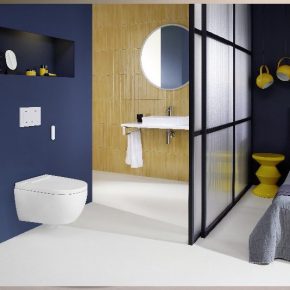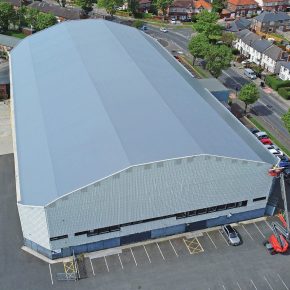
GDHV: Should we specify direct electric solutions into existing homes to meet net-zero?
The consultation revising Part L for existing homes raised challenging conversations across industry on how we will tackle the existing housing stock to reach net-zero in 2050. One of the more complex of these is addressing the decarbonisation of heat and the role of direct electric solutions. Glen Dimplex has more…
As the UK moves toward the electrification of heat and the net-zero target, the government will need to introduce specific measures to help transition the existing housing stock towards more sustainable solutions.
This is will be no mean feat, with the cost and complexity of addressing privately owned homes a vital yet difficult landscape for Government to navigate. The key to doing so correctly, alongside well-managed financial incentives, is to bring the public on this journey rather than enforce it upon them, an element of which must be to offer choice and flexibility.

With this in mind, what can direct electric solutions offer to the decarbonisation of heat, and why should Government support them alongside heat pumps as a natural-gas alternative?
There is no silver bullet…
There is no silver bullet to reaching the 2050 target and in some existing dwelling direct acting solutions will be the best, and possible only net zero compliant, retrofit for that project.
When heat pumps can’t be used
Although heat pumps are certainly a key technology in our future, not all existing dwellings easily lend themselves to them in the short to medium term, as noted in BEIS recent Heat Distribution Systems report. Where they are not feasible, homeowners should not have to stay with a higher carbon solution when suitable alternatives are available. Heat pumps may not be suitable due to lack of space, budget constraints or occupant requirements and preferences.
This is where hybrid systems containing a heat pump element can be introduced as a complementary interim measure to the full uptake of heat pumps. An example would be pairing a hot water heat pump with direct acting panel heaters or high heat retention storage heaters.
In this specification instance the capital cost of heating and hot water upgrades would be lower, leaving budget for additional measures such as fabric improvements and controls. This would further reduce the primary energy usage and carbon impact of the new system when compared to that which is being replaced. The regulations should therefore not discourage this type of improvement.
As gas becomes more expensive
Government is looking to address the levy imbalance across gas and electric, as suggested in the Cost of Energy Review. When this change takes place, home owners will be looking to transition away from gas-based systems, and there should be as many alternatives as possible which allow them to do this, for a range of capital and operational budgets, to avoid the exclusion of low-income households and the fuel poor.
Direct acting solutions offer design flexibility and a low-cost solution to futureproofing small, well-insulated houses and flats. Should direct electric not be an option, there could be a rise of those living in fuel poverty who are unable to afford to retrofit a heat pump solution. No appropriate technologies should be ruled out for these homes to transition to, or homeowners could be trapped into staying with a higher cost energy source.
To align with spending caps
For landlords, consultations around spending caps on refurbishments could create contradicting scenarios, such as those included in the call for evidence ‘Improving the Energy Performance of Privately Rented Homes in England and Wales’. The cost and complexity of traditional heat pump application could mean that landlords surpass the threshold for required spend which may put them off making any improvements.
It is better in these circumstances to have a range of electrification options that enable the application of a hybrid electric heat pump solution. As in the previous example, a lower capital cost hybrid solution would leave funding for fabric improvements, which combined with the ongoing reduction of carbon and primary energy associated with electricity, would produce a significantly better performing building compared.
For system diversity and demand side response
One of the key concerns around the specification of direct electric solutions is grid capacity. However, retrofitting the existing housing stock to enable flexible energy storage, through technologies such as the Quantum High Heat Retention Storage Heater, would mean that renewable production could be prioritised over fossil fuels and wind curtailment could be reduced or removed.
The below graph from National Grid shows how important enabling demand side response (DSR) is for our likely net zero scenarios. Government should not limit system diversity for properties of electrical design. Preventing diversity by restricting alternative systems that can facilitate flexibility will create a future issue as heat pump technology, and the growing impact of its load profile, becomes more prevalent on the UK grid.
Demand side response contributions at peak times in 2050 (FES 2020) (Clean heat: Heat decarbonisation and its implications for electricity and gas system operation, National Grid)
To compliment smart tariffs and meters
As the UK continues to roll-out smart meters across the existing housing stock, there has been an emergence of smart electricity tariffs by companies such as OVO Energy.
Smart connected direct electric heaters, high heat retention storage heaters and sanitary hot water heat pumps, all linked to such tariffs, could make a substantial contribution to grid decarbonisation and the electrification of low carbon heat. What’s more is that these systems would grow and contribute alongside other industry electrification plans, such as the rollout of smart electric vehicle charging models.
This should be a supported pathway to net-zero, encouraging smarter tariffs and greater diversification of specification to reach GDHV’s 2050 goal, rather than discounting viable technologies which we may some day soon come to rely on.
Remaining flexible in addressing the challenge
Getting the existing housing stock to net-zero is going to require specification flexibility. Industry needs to use the best solution for each project and not be forced to shoe-horn options which do not fit all requirements or budgets.
GDHV’s HVAC portfolio has been designed to offer you choice when specifying low carbon technologies into new or existing projects. To learn more, book a CPD online or request a call with a specification specialist.
Latest news

23rd April 2024
Geberit brings Parallel World to Clerkenwell Design Week
Visitors to this year’s Clerkenwell Design Week (21 – 23 May) can step into a parallel world and discover the benefits of cleaning with water, thanks to Geberit.
Posted in Articles, Bathrooms & Toilets, Bathrooms, Bedrooms & Washrooms, Building Industry Events, Building Industry News, Building Products & Structures, Building Services, Exhibitions and Conferences, Innovations & New Products, Interior Design & Construction, Interiors, Plumbing, Restoration & Refurbishment, Retrofit & Renovation
23rd April 2024
Mitsubishi Electric Ecodan Heat Pumps and Water Cylinders to be stocked by The Boiler Shop
Mitsubishi Electric’s full range of Ecodan heat pumps and hot water cylinders are to be stocked by one of the north-west’s best established independent merchants, The Boiler Shop.
Posted in Articles, Building Industry News, Building Products & Structures, Building Services, Facility Management & Building Services, Heating Systems, Controls and Management, Heating, Ventilation and Air Conditioning - HVAC, Plumbing, Posts, Retrofit & Renovation, Sustainability & Energy Efficiency
23rd April 2024
Trio of Senior products used in new Nottingham residential scheme
Solutions from Senior Architectural Systems have helped complete The Barnum – a new residential development on Nottingham’s Queen’s Road.
Posted in Aluminium Products, Articles, Building Industry News, Building Products & Structures, Building Systems, Case Studies, Curtain Walling, Doors, Glass, Glazing, Posts, Restoration & Refurbishment, Retrofit & Renovation, Walls, Windows
22nd April 2024
New EJOT role will develop strategic support for UK flat roofing sector
EJOT UK has taken a major step in the expansion of its support for the flat roofing market by appointing one of its most experienced building envelope fastening specialists as its first sector-dedicated business development manager.
Posted in Articles, Building Industry News, Building Products & Structures, Building Systems, Innovations & New Products, Posts, Recruitment, Restoration & Refurbishment, Retrofit & Renovation, Roofs
 Sign up:
Sign up: